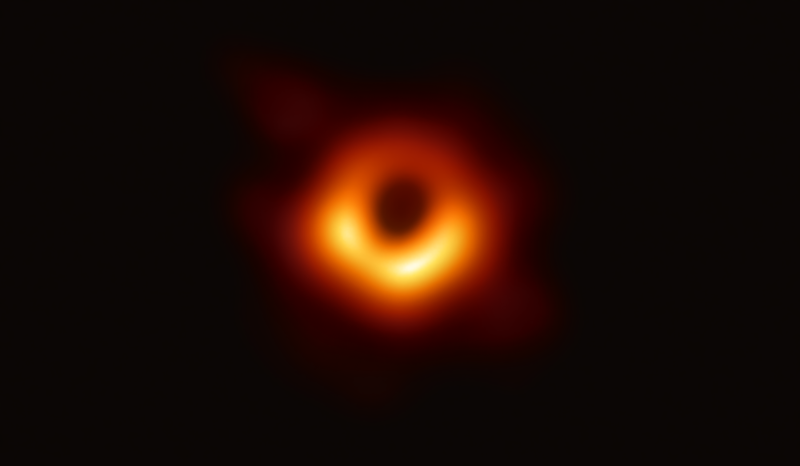This is the first ever photo of a black hole

This soon-to-be famous image, courtesy of the Event Horizon Telescope (EHT), is our first picture of the black hole that sits inside Messier 87 (M87), a galaxy located more than 53 million light-years from Earth. It has a mass 6.5 billion times that of the sun.
This bright image was revealed by researchers at a number of worldwide press conferences today, and detailed in a set of papers in the Astrophysical Journal Letters. It shows visual evidence of the event horizon of a black hole and allow us to see something previously thought to be invisible.
“History books will be divided into the time before the image and after the image,” said Michael Kramer from the Max Planck Institute for Radio Astronomy in one of the press conferences.
But how do you take a picture of something that doesn’t radiate light? Well, rather than looking directly at the black hole itself, the EHT looks at gas surrounding it to take an image of its shadow. Specifically, researchers looked at the event horizon, the limit beyond which light can no longer escape the intense gravity of the black hole. The gas in this area heats up to billions of degrees, creating a silhouette whose shape should be predicted by Einstein’s theory of relativity. So far, the Event Horizon Telescope’s observations are in line with what he anticipated.
That shadow is revealed in the center of today’s picture against a backdrop of glowing light that is being pulled in by the black hole’s incredible gravity. You’ll notice one side of the image is actually brighter than the other. That is because of the black hole’s orientation relative to Earth. The brighter side is the one rotating toward Earth, meaning the particles are being thrown toward our planet faster on that edge, making them appear to glow brighter.
Astronomers around the world celebrated today’s unveiling. “Having spent about 20 years helping to visualize the high-energy universe, I am seeing this silhouette of a black hole. That it happened in my lifetime is incredible,” says Kim Kowal Arcand, visualization and emerging-tech lead for the Chandra Observatory.
“This is to me the cherry on top of an amazing rush of astronomical discovery: moving from what was in the realm of science fiction to science fact.”
The image was created using radio astronomy. Most radio astronomy is done using large dishes that capture radio waves hitting Earth. But creating an image of the black hole required a telescope quite a bit larger. Researchers needed one the size of our planet.
That’s why the Event Horizon Telescope combined measurements from radio observatories on four separate continents. The array is currently made up of sites in North America, South America, Europe, and Antarctica, with other locations being included over its life cycle. When all dishes take measurements at the same time, they can be combined into a conglomeration of data, similar to what’s taken on a smaller scale in radio dishes. (Check out a great explainer video that goes into more detail here.)
The information used to make the image revealed today comes primarily from data taken in April 2017. Over the past two years, researchers have worked to turn that information into the clearest image possible by syncing up the measurements taken concurrently around the world. In 2018, an observatory in Chile was added to help create a clearer photo, after the initial results that came back were a tad foggy.
The reveal of the image is a huge milestone for the study of black holes. “While we confirmed the existence of black holes and studied their properties in so many ways, nothing beats a direct observation,” University of Southern California professor Clifford Johnson told MIT Technology Review in advance of the announcement. “It’s rather like seeing the shots fired as well as the smoking gun.”
Next up, though: figuring out what’s actually going on inside the black hole. This image is a major step toward solving the puzzles of these mysterious objects, but exactly what’s beyond that glow is still a challenge waiting to be solved.
Correction: The initial version of this article misstated the location of the galaxy. We have now updated it.
Deep Dive
Space
How to safely watch and photograph the total solar eclipse
The solar eclipse this Monday, April 8, will be visible to millions. Here’s how to make the most of your experience.
How scientists are using quantum squeezing to push the limits of their sensors
Fuzziness may rule the quantum realm, but it can be manipulated to our advantage.
The great commercial takeover of low Earth orbit
Axiom Space and other companies are betting they can build private structures to replace the International Space Station.
Stay connected
Get the latest updates from
MIT Technology Review
Discover special offers, top stories, upcoming events, and more.